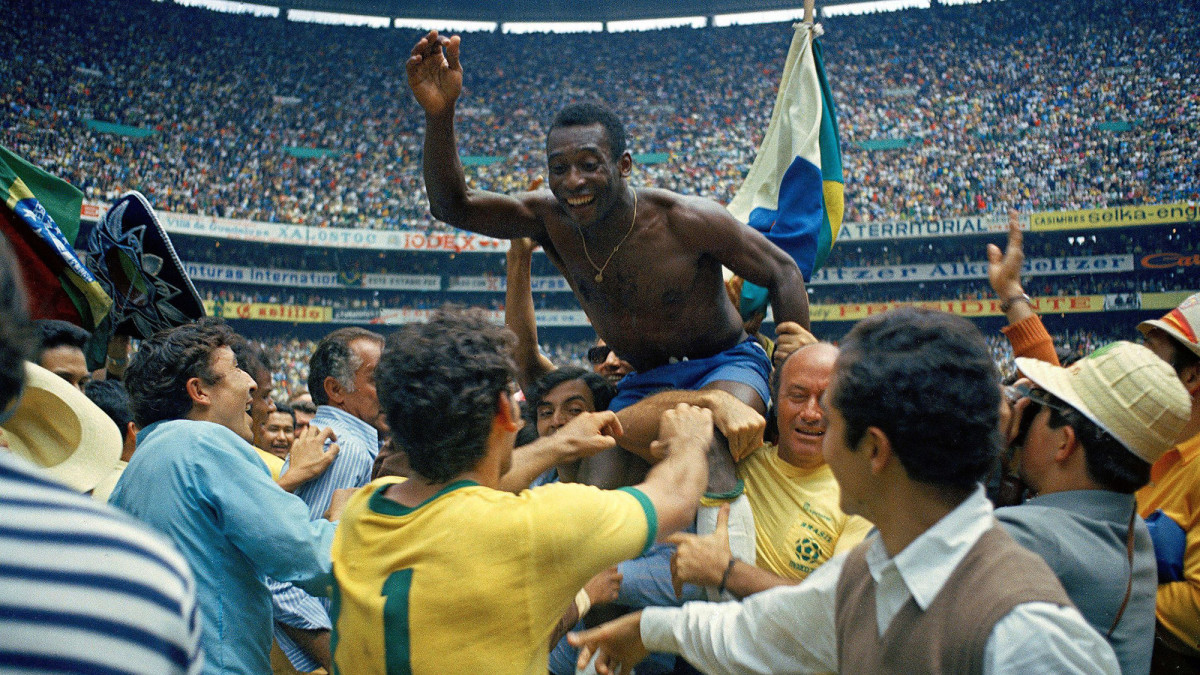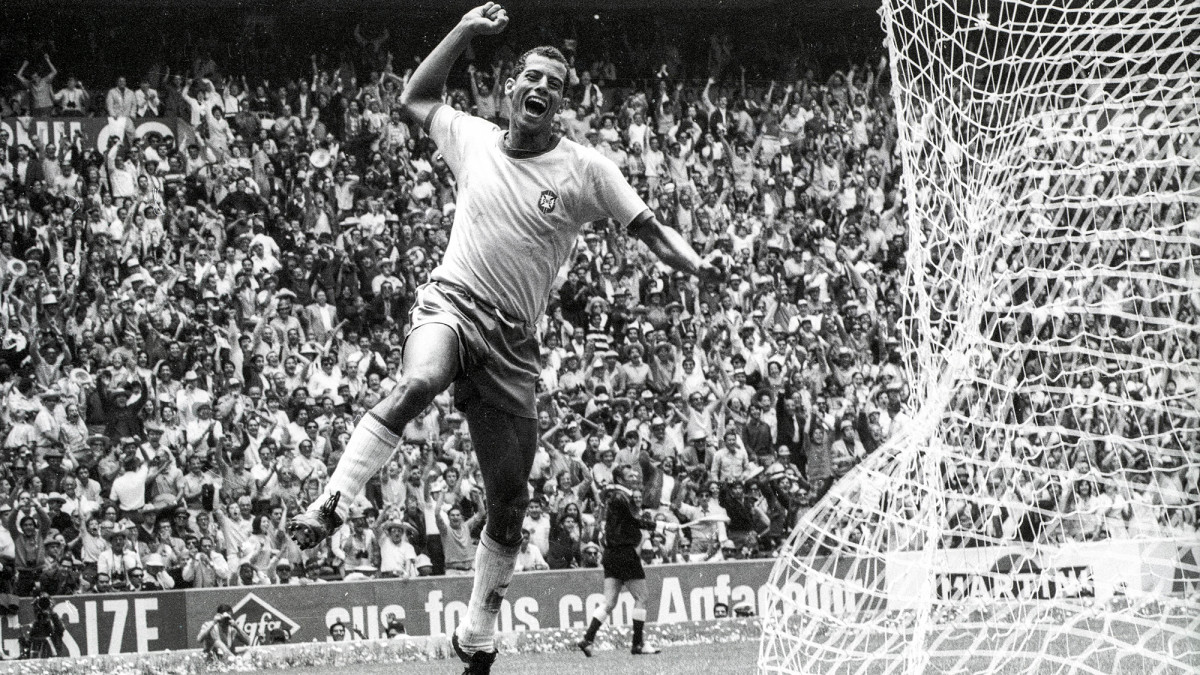The 50-Year Legacy of the 1970 World Cup and Brazil's Historic Triumph
Football, historically, has been very bad at understanding whether a bloom of brilliance is the beginning of a new age or the end of an old one. It’s tempting always to take the optimistic line and believe that this is how it will be from now on, but it’s also the case that what is celebrated is what we understand; the revolutionary often provokes unease. The tendency is always to believe each achievement is another step on a staircase of progress when just as often it is the culmination of a process coming to its end. Perhaps no event stands so obviously on a fault line as Mexico's 1970 World Cup, arguably the greatest international tournament there has ever been, won by arguably the greatest team there has ever been.
The grainy footage, the commentary crackling down a telephone line, the heavy cotton shirts, the football reduced by heat and altitude often to walking pace–none of it seems very modern now, but at the time, this was something thrilling. The tournament was broadcast live in color for the first time, the Telstar satellite sending images of the iridescent Mexican heat and Brazil in its vibrant yellow shirts and cobalt blue shorts around the globe. For the first time at a World Cup, the ball wasn’t brown leather but white with black panels–a design so striking that it still informs the popular conception of a football 50 years on; it caught the futuristic mood by being named after the satellite.

The stereotype of Brazil imagines its players wandering off the beach to produce their samba brilliance spontaneously on the pitch, but nothing could be further from the truth. From the mid-1940s, Brazil had been tactically pioneering, and from the 50s it had taken preparation far more seriously than most countries. Before 1970, the squad underwent a NASA training program, the metaphorical significance of which seems to have been lost on nobody. After Brazil had beaten Italy in a final capped by Carlos Alberto’s brilliant fourth goal, the Jornal do Brazil claimed that “Brazil’s victory with the ball compares with the conquest of the moon by the Americans.”
It’s a comparison that initially seems ludicrous, but it’s instructive to examine it more closely. To begin with, there is the use of abstract terms: “victory with the ball" and conquest of the moon.” No opponent is mentioned. It’s as though the triumphs, which happened less than a year apart, come to be regarded as a greater endeavor, a victory attained less against corporeal rivals than over external, nonhuman elements, as though to play football of that majesty were somehow a victory for all of humanity.
From that perspective, it’s perhaps fitting that the most venerated moments of the tournament are essentially non-competitive: Pelé’s lob from the halfway line against Czechoslovakia did not go in. Having extravagantly dummied Uruguay goalkeeper Ladislao Mazurkiewicz in the semifinal, he then missed an open goal. Gordon Banks’s save from Pelé was remarkable in itself but follows a stretch of mesmerizingly beautiful football–a brilliant pass down the line from Carlos Alberto with the outside of his right foot, followed by a fine cross from Jairzinho–and ends with Pelé congratulating Banks.
Even Carlos Alberto’s famous goal in the final, which marks its 50th anniversary on June 21, came with four minutes to go when the outcome was already decided. This was futebol arte in its most literal sense, celebrating not events that determined the result, but passages of play that transcended the immediate context of the matches in which they happened.
It can be debated whether the moon landing was the supreme technological achievement of the 20th century and whether Brazil’s 1970 World Cup success was the supreme sporting achievement, but what is certain is that no other event in either sphere had such an immediacy of impact, such a universal symbolic importance. The reason for that is simple: television. Neil Armstrong’s one small step and Carlos Alberto’s ferocious angled drive became the first two great global events of the telecultural age, clips to be repeated and reviewed for the rest of time. As if to underline the symbolic link, the second moon landing happened on the day Pelé scored his 1,000th career goal.
Technology, though, was a facilitator, not a cause. The 1970 World Cup was able to gain its status because it was seen by so many and in such dramatic color, but it wouldn’t have mattered had Brazil not been so much fun to watch. Its fallibility was part of its charm. It scored goals but it conceded them as well, keeping just one clean sheet in six games – against the defending champion England, the side that probably pushed it hardest.
5️⃣0️⃣ years later... 🎬
— FIFA World Cup (@FIFAWorldCup) June 17, 2020
It’s the 1970 #WorldCup like you’ve never seen it before 🏆🌐#WorldCupAtHome | #Mexico70 pic.twitter.com/MjI2NZjrB7
“Those last minutes,” the journalist Hugh McIlvanney wrote in his match report of the final for The Observer, “contained a distillation of their football, its beauty and élan and almost undiluted joy. Other teams thrill us and make us respect them. The Brazilians at their finest gave us pleasure so natural and deep as to be a vivid physical experience … the qualities that make football the most graceful and electric and moving of team sports were being laid before us. Brazil are proud of their own unique abilities but it was not hard to believe they were anxious to say something about the game as well as themselves. You cannot be the best in the world at a game without loving it and all of us who sat, flushed with excitement, in the stands of the Azteca sensed that we were seeing some kind of tribute.”

In 1962, President John F. Kennedy had acknowledged the start of the space race and had diverted enormous amounts of scientific, technological, financial and emotional resources into winning it. That same year, Brazil won its second World Cup and began the race to become the first side to win a third. Feeling its players had been physically overpowered in England in 1966, Brazil’s military government put the squad through previously unimaginable preparation. Each player was given a pair of individually fitted handmade boots, while two weeks before departure the players began living on Mexican time with a strictly controlled program of diet and sleep. Even their kit was redesigned so as not to become weighed down by sweat. A victory of spontaneity and flair, yes, but also of science and management.
Was this, then, the future? Brazil had a team that was impossibly attack-minded. Clodoaldo held in midfield, but Gerson, Rivellino, Jairzinho, Tostao and Pelé were all creators. Amid all the technology and the sense of the World Cup entering a brave new world, the success of that Brazil was a victory of the old football, when games tended to be won by the teams with the best individuals. But football was changing. Catenaccio had dominated European club football in the 1960s. England in 1966 had shown the possibilities of a packed midfield, physicality and discipline. Estudiantes, proud exponents of anti-futbol, were on a run of three successive Copa Libertadores titles. Dynamo Kyiv, Feyenoord and Ajax were developing pressing. Football was becoming a game less about individuals than about systems. Football was losing its innocence.
As the academic Tomas Peterson later said of the move away from individualism in Sweden, watching the new football was like to listening to Charlie Parker after Glenn Miller or viewing Picasso after classical landscapes. “The change does not just lie in the aesthetic assimilation," he said. "The actual organization of art and music happens on a more advanced level.” Naivety is gone, and there is a second order of complexity.
In Mexico, where the heat and the altitude made pressing impossible, where the game was slowed down so that artistry emerged again, Brazil, elevated by intense preparation, won a victory for the artistic football of the past. Even it, by 1974, had switched to something more physical, less full of flair. There were flickers of the old school under Tele Santana in the 1980s, but by the time Brazil next won the World Cup in 1994, the heart of its midfield was not a player of the elegance of Gerson, but the dogged spoiler, Dunga. In 1958, Brazil had Didi and Zito in the middle of midfield; by 2010 it had Gilberto Silva and Felipe Melo.
And for a while it worked. Between 1994 and 2002, Brazil played in three successive World Cup finals, winning two of them. It won four of the five Copa América tournaments held between 1997 and 2007, all of them on foreign soil. But those successes prompted nothing like the same joy or global admiration as 1970.
For all the modernity of the trappings, Brazil in 1970 was a final celebration of the old football.
